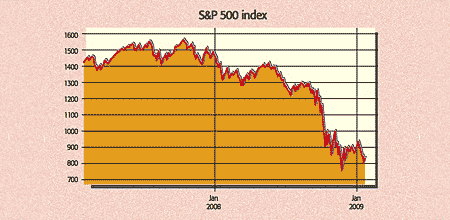S&P 500 faces a 40% slump
The average strategist's forecast is for a 27% rise in the S&P 500 by the end of the year. But that's far too optimistic. This isn't just a nasty recession, it's a deflationary credit-bubble collapse.
Even though last year proved disastrous, most US strategists are undaunted. The average forecast in a Bloomberg survey last week foresees a 27% rise in the S&P 500 by the end of the year. But the index has made a shaky start. It has slid by around 6% amid turmoil in the banking sector, the deteriorating economic outlook America looks set for the worst recession since the war and constant earnings disappointments.
Investors were hoping that fourth-quarter results would bring at least "a glimmer of light at the end of the tunnel", says Eric Savitz in Barron's. "It turns out that no one can even find the damned tunnel." Last March, analysts were expecting a 55% rise in S&P 500 profits for the fourth quarter. About a fifth of the results are in, and so far earnings are down by 47%, undershooting the 32% fall currently expected.

More capital will be needed: Nouriel Roubini of New York University estimates that US banks will lose a total of $1.8trn in this credit crisis and will need about $1trn to "restore capital ratios to adequate levels". Another problem is that while the supply of credit is constrained, demand is also down people don't want to borrow. This lack of demand is now "driving the deleveraging process and deepening the recession", says David Roche of Independent Strategy. The key is a sea-change in the attitude to credit among consumers, says David Rosenberg of Merrill Lynch.
Subscribe to MoneyWeek
Subscribe to MoneyWeek today and get your first six magazine issues absolutely FREE

Sign up to Money Morning
Don't miss the latest investment and personal finances news, market analysis, plus money-saving tips with our free twice-daily newsletter
Don't miss the latest investment and personal finances news, market analysis, plus money-saving tips with our free twice-daily newsletter
Consumers, who account for over 70% of the economy, have finally stopped spending on the never-never and are cutting back. Official surveys show that "household willingness to add to their debt burdens is virtually nil", while over the past six months spending on discretionary goods has fallen at an average annual rate of 15%.
No wonder. Between the peak in mid-2007 and the end of last year, the slide in equity and house prices meant that household wealth fell by around $13trn, or an unprecedented 20%, calculates Rosenberg. The process isn't over, with house prices set to fall another 15%. History shows that this will boost the savings rate as consumers hunker down. The negative wealth effect implies a drain on consumer spending of 2%-3% a year over the next two to three years. This year it could lower GDP by $350bn, and that's before job losses and lower wages cause even more consumer jitters. Factor this in and the drag on GDP in 2009 could be about $875bn, reckons Rosenberg. Government measures are likely to merely soften the blow. Increasing the overall downward pressure is the fact that private-sector debt is still 50% above its pre-bubble norm at 172% of GDP. There's a huge amount of debt to pay down before the credit cycle can resume.
In short, what most pundits don't seem to realise is that this isn't just a nasty recession. It's a deflationary credit-bubble collapse, and with inflation already heading for zero, a Japan-style slump is a real possibility. Throw in the fact that US equities typically bottom with p/es in single digits after major bear markets we are still at 16 and there's still lots of downside. In fact, Albert Edwards of Socit Gnrale sees the "deflationary quagmire" wiping another 40% off the S&P.
-
 British Airways revamps Avios scheme bringing down flight prices to £1
British Airways revamps Avios scheme bringing down flight prices to £1With the new Avios part-payments scheme you can now bag a British Airways flight for as little as £1
By Oojal Dhanjal Published
-
 RBS to close a fifth of branches
RBS to close a fifth of branchesRoyal Bank of Scotland plans to shut 18 branches across Scotland, resulting in the loss of 105 jobs. We have the full list of closures.
By Ruth Emery Published